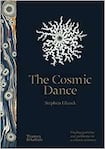
In the preface to this visually overwhelming, profoundly uplifting book, Stephen Ellcock describes himself as “a burnt-out, punch-drunk, middle-aged man” whose absence of perspective, a decade ago, led him “to come apart at the seams, lose his bearings and find himself adrift in a world of pitfalls and unsprung traps, engaged in a perpetual war not only with himself but with friends and enemies, both real and imagined”.
The Cosmic Dance is the astonishing result of the 10 years Ellcock spent regaining his perspective: “a quest to find his place in space”. He reconnected with the world, and indeed the universe, through images, “the infinite archive of images that was suddenly and freely available online”.
And so The Cosmic Dance collects the best of the best of these images, from across all of space and time and culture. Woodcuts, photographs, seashells, blueprints, ceremonial carvings, X-rays, oil paintings, alchemical texts, carved rocks and woven blankets mingle here with promiscuous glee.
Throughout, Ellcock’s curation of these images is a marvel of sympathy. A German 16th-century castle stairway calmly mirrors the stone spiral of a fossil snail. A modern English crop circle is put in animated conversation with an ornate Italian church cupola. A 1930s photograph of sliced onions by Midori Shimoda – a dream of silvery, circular stillness – lies opposite an ink drawing of waves by Louise Bourgeois (a nightmare of jagged, spike-tipped, frozen rage). They balance each other perfectly. You could look at that two-page spread for an hour, as it deepens and resonates. It is a visual koan.
I’d been insured for just one week when I crashed into a shiny black BMW
Easter activities: 10 family-friendly days out and events to enjoy over the holidays
Hyrox, the soaring fitness trend: ‘You meet so many different people, all shapes, all sizes’
The Last of Us review: Prepare to be shocked by this compelling new season
Meanwhile, the book’s accompanying text marches you briskly through a magnificent number of the world’s mythologies, religions, philosophies, arts and sciences, drawing connections and noting similarities.
Exuberantly unpredictable
The images, though exuberantly unpredictable, are not random: the book has an arc, from microscopic to macroscopic. Starting with the fizz of the subatomic and the rapid pulse of the bacterial, it leads you gently outward and upward, through the intermingled realms of humans, animals and plants, past the stately spinning planets, beyond the galaxies that take a billion years to rotate just once, until you are gazing upon the universe as a whole; the mysterious organism that generates all these marvellous moments at every possible scale.
There are points where you can get a little dizzy, a little lost. Am I looking at a computer-generated mathematical fractal or the intricate blue ceiling of a mosque? Crystallised ascorbic acid or the antenna of a moth? Finally, you realise that these questions don’t matter. Everything here, seen at the right scale – zoom in enough, zoom out enough – is alive and significant and beautiful. As Annie Dillard puts it, in one of the many marvellously chosen quotations that pepper the book: “Crystals grew inside rock like arithmetic flowers.”
If you know any punch-drunk middle-aged burnouts, buy them this book for Christmas. Give them the gift of perspective. Maybe even save their life.
Julian Gough is the author of the Rabbit & Bear children’s books (illustrated by Jim Field). His most recent novel is Connect. He is currently writing The Egg and the Rock (a non-fiction book about the universe), in public, online, at theeggandtherock.substack.com











